
| What is Flavor and Fortune? |
| How do I subscribe? |
| How do I get past issues? |
| How do I advertise? |
| How do I contact the editor? |
Read 12965343 times
Connect me to:
| Home |
| Articles |
| Book reviews |
| Letters to the Editor |
| Newmans News and Notes |
| Recipes |
| Restaurant reviews |
| Article Index (all years, slow) |
| List of Article Years |
| Article Index (2025) |
| Article Index (last 2 years) |
| Things others say |
| Related Links |
| Log In... |
| Authors |
| Categories & Topics |
Mushrooms are Magnificent
| by Jacqueline M. Newman |
Mushrooms
Spring Volume: 2019 Issue: 26(1) pages: 8 to 13
The most common mushroom, worldwide, is the button mushroom. A Chinese poet, Yang Wanli, wrote “After a rain, round mushrooms pop up from the steamy soil.....are as sweet as honey....with a fragrance that lingers between the teeth.” TCM medical practitioners say eating these mushrooms can reduce blood pressure, increase appetite, shrink tumors, help those with hepatitis, and numbness.
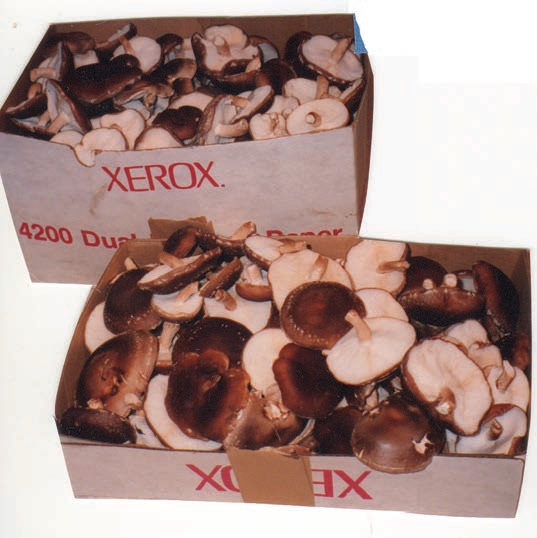
Would that all this were true. In the culinary realm, all mushrooms are magnificent and go well with virtually all foods, make everything taste better; and they are loaded with many glutamates, provide umami which is a basic sense to taste buds. The other tastes, in case you forgot, are sweet, sour, salty, and bitter. If you are Chinese, they add another one they call ‘pungent’ or ‘flavor enhancing.’ Matters not what you call it, every mushroom has lots of glutamates; they increase enjoyment of all tastes.
More than a hundred countries grow edible mushrooms above ground, many but we know not how many are grown at ground level, and others are grown under ground. Now, more than twenty different mushroom varieties grow indoors on various kinds of compost or logs made grinding various different woods. They are productive and easily available, and if you never grew any, try doing so.
My husband did so starting a long-term undertaking when I went to China on sabbatical. He drilled hundreds of holes in freshly cut six foot sections of oak logs and filled them with spores. Then, he did need to cover them with beeswax so the spores would stay in the holes of a half-inch drill bit. He told me it took him days to do this. He did not start small when I was not home. He figured he has months to complete this task as there were about a hundred logs, and each log needing fifty or more holes in it. I never counted them and I am not sure he did either.
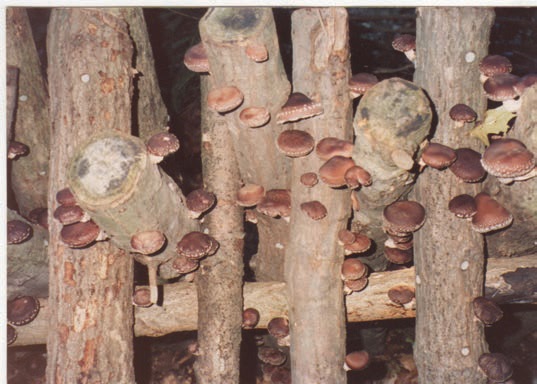
Next, he stacked the logs and put a soaker hose on top; it had many tiny holes and did keep the logs wet using very little water. It was always on for about six months. Then, he leaned them alternating, front and back, on a thick iron pipe acting as a cross bar. These he watered about once a week if it did not rain that week, and did for a few months. Enjoy the pictures of them. We enjoyed the hundreds of pounds they produced every fall, fewer each Spring, for about five years. This process was repeated several times until we moved to a Life-care Retirement Community as it could not be done there. I miss the tiny buds and the many mushrooms generated from the drilled holes, and then from the cracks up and down most logs.
They stayed leaning on those cross bars in the shade under other live oak trees all that time. We did enjoy them the first and subsequent years as they produced handsomely and we harvested more than their initial investment each and every year until there were no spores to produce more mushrooms.
Produce they did, every tiny round protuberance growing larger until a recognizable mushroom appeared. We did cut a few when small, left most to get big, and some did that overnight. When a size we wanted or appreciated, we cut the mushroom away from the log and either cooked it fresh or dried it in a six layer plastic fruit and vegetable drier rotating the layers to allow these wonderful shiitake mushrooms to dry evenly. When very dry, we stored them in large plastic jars in our cool dry basement. They produced every fall and spring, more the former months, until the logs became spongy holding no more spores.
My husband, six years later, cut down fresh oak trees into six foot lengths, drilled hundreds of holes in them, I could watch as I was no longer on sabbatical, and began the process started again from stacking, wetting, leaning on the iron cross bars, etc. until these logs began producing more shiitake mushrooms. We tried oyster mushrooms on composite logs outside and inside, but they were less productive.
Fossil records did show us that shiitake and other mushrooms grew more than a million years ago in China. We read about them in Taishang Lingbaozhi Caopin in the closing years of the Eastern Jin Dynasty (circa 420 CE) and elsewhere. They discussed their flavor, texture, medicinal, and tonic attributes.
The shiitake mushrooms had great aroma, and they enhanced every dish we prepared with them. Restauranteur chefs know that fresh ones are tender and easily damaged, and if aroma-free at room temperature are probably immature or past their prime. That said, do smell them before using or purchasing yours.
Many different mushrooms are popular in Asia, some enjoyed fresh, others dried, canned, or pickled. In China, the black shiitake ones, also called ‘black forest mushrooms, fragrant mushrooms, flower mushrooms, Chinese black mushrooms;’ and called “shiitake mushrooms’ are most loved. That is their Japanese name, and they have been used for thousands of years, always produced in shady areas, best grown on hardwoods, and very productive. Below we discuss eight common mushrooms the Chinese adore.
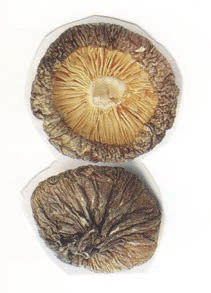 Shitake botanically
known as Lentinula
edodes, have been revered
for thousands of years and
used for food and medicine
throughout Asia. We know
them well, grew them
successfully in the shade in
our north shore Long Island
backyard.
Shitake botanically
known as Lentinula
edodes, have been revered
for thousands of years and
used for food and medicine
throughout Asia. We know
them well, grew them
successfully in the shade in
our north shore Long Island
backyard.
It was time consuming to drill the many holes in freshly cut oak logs, but only necessary every five or six years, then stacked them, soaked them, and kept them wet for some months, then they sat on an iron crossbar, leaning side by side in opposite directions, and they were very productive for five or six years.
We were rewarded with two crops each year after just a few their very first year with lots of mushrooms in the Fall, a smaller batch in the Spring. The only work needed was grabbing a knife and cutting them off the logs, many more than we could use at any one time. The box and its cover (on page 8) are one cutting’s worth one Fall, more that a hundred pounds each fall from six dozen logs. We did need to remove their stems, and put most in our fruit and vegetable dryer. re-arranging its layers to dry them evenly.
We did read that spores can also be grown on sawdust logs, but we never tried that as we heard they were not as productive as fresh logs would be. Cooking and consuming these mushrooms have a long history, few are allergic to them, and growing them was fun and a delight to savor our efforts. We want to share that if you cook them with an American quarter and it turns black then they are poisonous is an old wive’s tale. Do not test it, as you can die doing so. In Asia and in our home, shiitake mushrooms are food, tonic, and great tastes! TCM colleagues tell us they are also medicines as indicated above.
Be aware that every mushroom variety has many different names, and learn them and learn ways to prepare them. Mushrooms are low in fat, have many B vitamins, and very few calories. Simply brush them clean with a soft mushroom brush. Do not wash them, and cook them, fresh, soaked if dried, drained, and then cooked to enjoy them.
Black forest shiitake mushrooms are most popular in Asia, are brown when fresh, black when dried and the best have many cracks on their cap’s surface. They are the most expensive, and the most flavorful. They can enhance one’s qi, improve one’s immune activity, treat one’s heart condition, and enhance circulation.
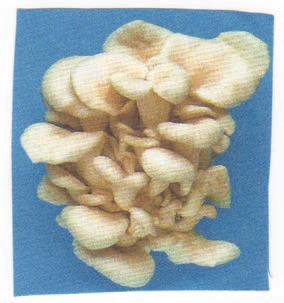 Oyster
mushrooms are
referred to by
many as ‘shellfish
of the woods’ and
are botanically
known by many
names in the
Pleurotus family.
Some know they
have convex caps
with frilly edges,
and can be white,
colorless, some gray or pinkish; while newer varieties
are silver colored or a newer tint. Their texture is soft,
resembles their seafood namesake, are mild, and have
a pleasant taste. Best known for their cardiovascular
and cholesterol lowering abilities, and they can inhibit
tumors. Doing so does seem to take time, and TCM
practitioners tell us this requires two or three months
to do so. The Chinese use them for joint and muscle
relaxation, and like them as they are easy to grow at
home, are excellent blood builders and they contain
lots of amino acids, and reasonable amounts of B
vitamins and iron.
Oyster
mushrooms are
referred to by
many as ‘shellfish
of the woods’ and
are botanically
known by many
names in the
Pleurotus family.
Some know they
have convex caps
with frilly edges,
and can be white,
colorless, some gray or pinkish; while newer varieties
are silver colored or a newer tint. Their texture is soft,
resembles their seafood namesake, are mild, and have
a pleasant taste. Best known for their cardiovascular
and cholesterol lowering abilities, and they can inhibit
tumors. Doing so does seem to take time, and TCM
practitioners tell us this requires two or three months
to do so. The Chinese use them for joint and muscle
relaxation, and like them as they are easy to grow at
home, are excellent blood builders and they contain
lots of amino acids, and reasonable amounts of B
vitamins and iron.
Portabella mushrooms, also known as Baby Bella or Crimini, are actually cousins of the common white button mushroom. They are tan or brown and with more intense flavor. Botanically known as Agaricus bisporus, they are buttery in texture, and best cut when their veils and gills are closed. One writer said the texture of these expensive mushrooms reminds him of a fine filet . We find that a stretch. He also says to rinse them and we say that is a no-no and we barely brush them or wipe them with a damp paper towel. When big, beautiful, and meaty, they are great grilled, broiled, or sauteed, and a wonderful meat replacer. Reported to play a role in breast cancer prevention, they also modulate coronary heart disease.
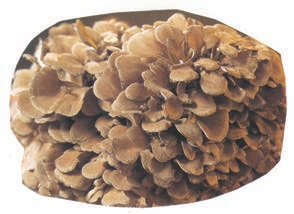 Maitake
mushrooms, the
Japanese say are
‘dancing’ or ‘flying’
in the wind as the
overlapping ends
of these Grifala
frondosa do look
that way. Large
ones can be as big
as old-fashioned watermelons. These frilly mushrooms
have an additional moniker of ‘the fungus among us’
thanks to this frilly look. Best breaking off pieces of
their clumps near the stem, smaller pieces are best
cooked just a little and said to improve the immune
system’s ability to fight infection. Researchers track
their ability to reduce lung, liver, and breast cancers
as they support general health, attack HIV, ulcers,
and other disease-attacking cells. They are immune-enhancing
and immune-boosting. Some say these
hen-of-the-woods should never be washed, just sliced,
dusted, and sauteed in oil or another fat, or stewed in
any one sauce. Wonderful with eggs, pasta, in soup
or a stew, every one should enjoy them for their many
health-related benefits including that they have very
few calories, many essential B vitamins, and large
amounts of selenium and potassium.
Maitake
mushrooms, the
Japanese say are
‘dancing’ or ‘flying’
in the wind as the
overlapping ends
of these Grifala
frondosa do look
that way. Large
ones can be as big
as old-fashioned watermelons. These frilly mushrooms
have an additional moniker of ‘the fungus among us’
thanks to this frilly look. Best breaking off pieces of
their clumps near the stem, smaller pieces are best
cooked just a little and said to improve the immune
system’s ability to fight infection. Researchers track
their ability to reduce lung, liver, and breast cancers
as they support general health, attack HIV, ulcers,
and other disease-attacking cells. They are immune-enhancing
and immune-boosting. Some say these
hen-of-the-woods should never be washed, just sliced,
dusted, and sauteed in oil or another fat, or stewed in
any one sauce. Wonderful with eggs, pasta, in soup
or a stew, every one should enjoy them for their many
health-related benefits including that they have very
few calories, many essential B vitamins, and large
amounts of selenium and potassium.
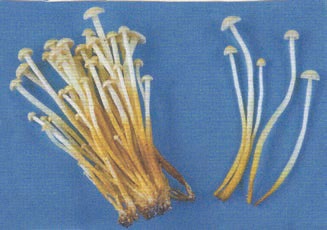 Enoki
mushrooms
used to be
botanically
known as Hericium
erinaceus
but are now
commonly called
Flammulina
velutipes. Once called pom pom mushrooms, these
days most have long thin stems, small white balls on
top, and are also known as Lion’s Mane, Monkey Head,
Hedge Hog, or Old Man’s Beard. Some say they taste
like lobster, and are useful treating stomach cancers.
One should reduce the humidity of the area they grow
in, particularly a few hours before breaking them off for
use, so they do not bruise.
Enoki
mushrooms
used to be
botanically
known as Hericium
erinaceus
but are now
commonly called
Flammulina
velutipes. Once called pom pom mushrooms, these
days most have long thin stems, small white balls on
top, and are also known as Lion’s Mane, Monkey Head,
Hedge Hog, or Old Man’s Beard. Some say they taste
like lobster, and are useful treating stomach cancers.
One should reduce the humidity of the area they grow
in, particularly a few hours before breaking them off for
use, so they do not bruise.
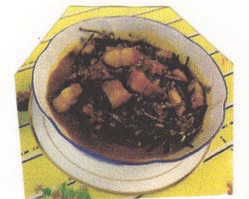 Cloud or Wood Ear
mushrooms are
botanically known as
Auricularia auricula.
TCM practitioners know
they benefit a persons
qi, nourish their blood,
stop bleeding, and ease pain. However, there are many
look-a-likes so they urge us to remind readers there
are many other mushrooms that mimic them and are
toxic. Do purchase yours from reputable dealers and
know that they can reduce cholesterol, reduce diarrhea
from a weak spleen, reduce blood in the stool, and
are good after childbirth when soaked in vinegar or
honey and brown sugar. Eating them can reduce heart
disease, reduce atherosclerosis and do likewise to fatty
deposits in blood vessels that could cause heart attacks
or strokes.
Cloud or Wood Ear
mushrooms are
botanically known as
Auricularia auricula.
TCM practitioners know
they benefit a persons
qi, nourish their blood,
stop bleeding, and ease pain. However, there are many
look-a-likes so they urge us to remind readers there
are many other mushrooms that mimic them and are
toxic. Do purchase yours from reputable dealers and
know that they can reduce cholesterol, reduce diarrhea
from a weak spleen, reduce blood in the stool, and
are good after childbirth when soaked in vinegar or
honey and brown sugar. Eating them can reduce heart
disease, reduce atherosclerosis and do likewise to fatty
deposits in blood vessels that could cause heart attacks
or strokes.
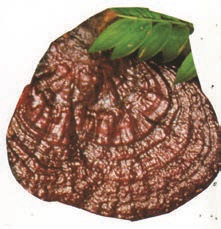 Ling Zhi mushrooms,
are known as the Reshi
mushroom. They are
hard and woody, and are
botanically known as
Ganoderma lucium. They
can be found whole or sold
powdered, as granules, or
as extracts, and as such are
used to treat liver disorders,
hypertension, arthritis,
relieve heart palpitations, pain, edema, lung disorders,
high blood pressure, high cholesterol and other serious
ailments. Originally rare and expensive, now they
can be artificially cultivated, are more accessible and
are affordable. That is great as their anti-allergic
effects lower blood sugar levels, boost immunity, and
surround cholesterol in the small intestine preventing
its absorption. This general tonic mushroom was
once called ‘phantom mushroom.’ They are now mass
produced, easily available, and believed to positively
impact strength, vigor, and longevity.
Ling Zhi mushrooms,
are known as the Reshi
mushroom. They are
hard and woody, and are
botanically known as
Ganoderma lucium. They
can be found whole or sold
powdered, as granules, or
as extracts, and as such are
used to treat liver disorders,
hypertension, arthritis,
relieve heart palpitations, pain, edema, lung disorders,
high blood pressure, high cholesterol and other serious
ailments. Originally rare and expensive, now they
can be artificially cultivated, are more accessible and
are affordable. That is great as their anti-allergic
effects lower blood sugar levels, boost immunity, and
surround cholesterol in the small intestine preventing
its absorption. This general tonic mushroom was
once called ‘phantom mushroom.’ They are now mass
produced, easily available, and believed to positively
impact strength, vigor, and longevity.
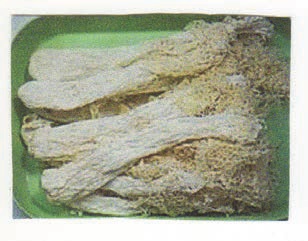 Bamboo
Fungus has,
since 1984, been
bred artificially. It
has a net-like veil
and is botanically
known as Phallus
indusiatus and
seen on the cover
when fresh. Once
one of three mushrooms reserved for royalty, several
hundred were transplanted to Empress Cixi’s royal
garden where they produced not a single one. The
Empress was infuriated and ordered the official in
charge decapitated and he was.
Bamboo
Fungus has,
since 1984, been
bred artificially. It
has a net-like veil
and is botanically
known as Phallus
indusiatus and
seen on the cover
when fresh. Once
one of three mushrooms reserved for royalty, several
hundred were transplanted to Empress Cixi’s royal
garden where they produced not a single one. The
Empress was infuriated and ordered the official in
charge decapitated and he was.
Now, they are found dry and in cellophane bundles. That Empress preferred hers fresh and with pigeon eggs and called ‘Moon in Gauze.’ No chef we talked to even heard of this dish even when we told them it was made with Bamboo Pith, Long Net Stinkhorn, or Veiled Lady mushroom. We heard they need rich soil and a well-rotted woody location for growth, have been known for their medical effects since the 7th century CE, grow only in tropical areas, attract hundreds of flies and other insects, and are known for their anti-microbial properties; still they knew them not.
Overall, the recipes that follow, and others in cookbooks and magazine articles are often not easily located. They can be listed under one of many headings and often not by the name of their mushroom. So begin looking for them in the meat, seafood, vegetable or soup sections. Readers tell us they are delightful in so many dishes, have a wonderful aroma, and they entice all at your table to enjoy them; and you should, too.
| Stuffed Black Mushrooms |
|---|
6 ounces minced or ground pork
1. Mix pork, with the minced water chestnuts, sugar, rice
wine, minced ginger, and the soy and oyster sauces.
|
| Bamboo Pith Dumplings |
|---|
2 cups flour
1. Mix flour with one cup boiling water, stir well, cover,
and allow to rest for ten minutes before kneading into
a soft dough. Divide into twenty pieces and roll each
one out. Cover them with a cloth and set aside until the
filling is made.
|
| Mushroom Fans |
|---|
1 pound button mushrooms brushed but not washed, their stems removed level with the bottom of their caps
1. Slice each mushroom into fans not cutting all the way
through from one end to the other.
|
| Crispy Monkey Head Mushrooms |
|---|
6 to 8 dried monkey head mushrooms, soaked for one hour in tepid water
1. Gently squeeze water out of the monkey head
mushrooms, then slice them thinly and soak these
slices in the ginger juice, rice wine, egg white, salt, and
the sugar for half an hour, stirring two or three times.
|
| Cloud Ear Mushroom Soup |
|---|
1 skinless and boneless chicken thigh
1. Cut chicken thighs and inside out wings into one-inch
pieces.
|
| Yin Yang Health Soup |
|---|
1 pound pork shin meat, cut into one-inch cubes
1. Put cubes of pork shin into boiling water and boil
them for two minutes, then drain and return them to
a clean pot.
|
| Sauteed Oyster Mushrooms |
|---|
3/4 pound oyster mushrooms
1. Break oyster mushrooms into small pieces.
|
| Vegetarian Eel |
|---|
10 large black mushrooms, soaked until soft, water squeezed out and set aside, if needed, the mushroom stems discarded
1. Cut mushrooms in thick spiral slices, then put them
in a paper bag with the cornstarch and shake well for
two minutes, then remove the mushrooms and set
them aside for an hour.
|

Copyright © 1994-2025 by ISACC, all rights reserved
Address
3 Jefferson Ferry Drive
S. Setauket NY 11720